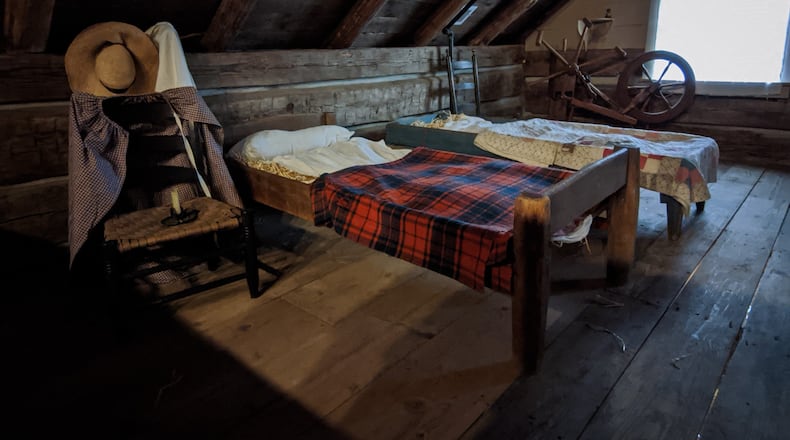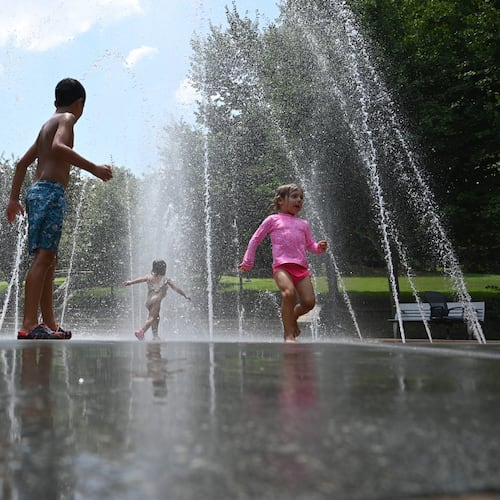The lives of slaves who lived in Marietta’s William Root House Museum & Garden are featured in a new exhibit.
The museum in December opened an exhibit with interactive touch screens that provides guests with a glimpse into the past.
The exhibit is set up as an enslaved person’s typical living space, which features the type of mattress on which he or she would have slept and the clothing they would have worn, said Trevor Beemon, executive director of Cobb Landmarks, which owns and operates the museum.
The Root House Museum was the home of William and Hannah Root, who lived in the home with their children and extended family from 1845 to 1886. The museum showcases the typical lifestyle for middle class families before, during and after the Civil War.
Beemon said he’s always wanted to incorporate the stories of the enslaved people who lived and worked on the property into the Root House story. His team began doing research on slavery in Marietta, but did not find a lot of information. He and his staff expanded that research to focus on slavery in urban settings, but that did not unearth any information that could help them.
READ: Marietta's Root House Museum getting $685,000 expansion
So, Beemon said the team went back to slave narratives written during the time frame and others recorded by Works Progress Administration officials in the 1930s. Using that information, along with U.S. Census records and Root family letters, the museum was able to piece together what the lives of enslaved people would have been like in the urban South.
“I think it’s our responsibility to share the entire story with people,” he said.
Credit: Root House Museum
Credit: Root House Museum
Marietta was settled as a resort community, Beemon said. Wealthy plantation owners from Savannah or Charleston, South Carolina, would come to the city in the summer to “get away.” They built vacation homes and “brought what they were accustomed to,” meaning the enslaved individuals they owned, Beemon said.
Since Marietta did not have many large plantations or cash crops, Beemon said slaves most likely worked at their owners’ homes or businesses, as well as in factories and mills. Auctions were held each year to allow individuals to rent an enslaved person for a year. Beemon said this was a huge fear among the enslaved population because they didn’t know who they would be rented to.
READ: Marietta's Root House Museum explores death, mourning in the 1850s
“It would have been really traumatizing,” he said.
According to Cobb Landmarks, the population of Marietta in 1860 was 2,600 people, 1,175 were slaves. Census records also show there were four enslaved people at the Root House property: two men and two women who were between 35 to 73 years old.
Civil War-era letters from the Root family, which were recently donated to Cobb Landmarks from family descendants, refer to a man named Lall. This name appears in 1867 black voter registration records as Lall Burge of Bartow County.
Credit: Root House Museum
Credit: Root House Museum
“Since ‘Lall’ is an unusual name, it may be presumed that this is the same person who lived with the Roots,” Beemon said, adding research indicates Burge belonged to Dr. Lorenzo N. Burge before going to the Root family.
Census records from 1860 and 1880 reveal the Roots had an enslaved woman. Her name does not appear in the 1860 Census, but she is referred to as Elsay Blake in the 1880 census.
Beemon said Cobb Landmarks is working with Kennesaw State University’s School of Art Design to install a sculpture outside the museum’s Visitor’s Center to memorialize the enslaved people who lived at the home.
The exhibit hopes to shed light on the more realistic side of Southern life in the mid 1800s, Beemon said. When visitors patronize historic homes transformed into museums, they are often given great details about the furniture, carpeting and wallpaper. When you focus on the nice things, you often “lose sight of the individuals,” Beemon said.
“People had to build those beautiful things, and they were forced to build these houses,” he said. “It’s important to take that into account and remember that when you’re visiting these sites.”
Like Cobb County News Now on Facebook | Follow us on Twitter
About the Author
Keep Reading
The Latest
Featured






